Trade Agreements In Supply Chain Management
Trade Agreements In Supply Chain Management
“Trade agreements are the primary means by which pricing and discounts are setup and applied in D365″.

Trade Agreements are the product of negotiations between two or more business unit from different nations or locations. It dictates the terms of the acceptable exchange of goods and services between the parties. In Supply Chain Management (SCM) when designing trade agreements it focuses to increase incentives for investment and scope. As in international businesses, the trade cost remains very high. They reflect a mix of discriminatory policies that inhibit the entry and operation of foreign firm that provide intermediate services and regulatory policies that is applicable to local and foreign firms and products. The foreign firm increases the cost for domestic suppliers because the trade regulations differs from country to country. More importantly, these policies raise costs across the board and thus the price of goods and services for buyers. Trade costs result from a variety of factors that drive a wedge between domestic and world prices for a product. That is where the Trade Agreement between such business units help in product regulation and customs valuations. A supply chain perspective will facilitate a focus on how different types and combinations of regulation/ policies affect key dimensions of supply and production chains and reduces efficiency/ raise costs.
Trade Agreements are the primary means by which pricing and discounts are setup and applied in D365 Finance & Operations. When D365 Fin & Ops evaluates trade agreements it tries to find the most specific pricing that falls within the validity dates. The most common use for a trade agreement is just a simple unit price for a product or service. This means the system checks the ‘party type code’ and ‘product type code’ to see the if there is a valid price specific to that customer or vendor for the specific product selected on the sales order or the purchase order line respectively. If it cannot find that most specific combinations it looks for the next level up which are the price groups and then finally if it cannot find prices at the group level it looks for prices that may apply to all vendors or customers.
There are two types of trade agreement in Microsoft D365.
- Sales Trade Agreement
- Purchase Trade Agreement
To create any above type of trade agreement, one has to activate the exact types and combinations of trade agreement to enable unless there is a specific reason not to.
For Sales Trade Agreement, Go to Sales and Marketing module> Setup> Prices and Discount> Activate (Enable).

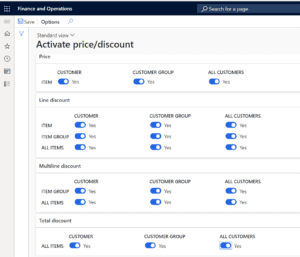
For Purchase trade Agreement, Go to Procurement and Sourcing> Setup> Prices and Discount> Activate (Enable).
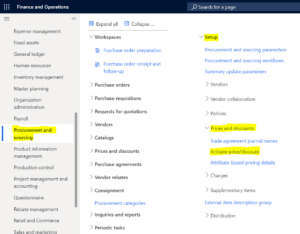
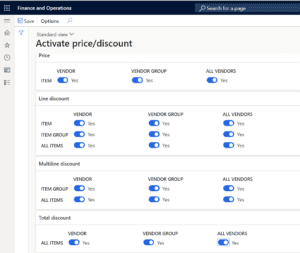
TRADE AGREEMENT SETUP (SALES TRADE AGREEMENT)
- Go to Sales and Marketing, click on Setup> Prices and Discounts and select Trade Agreement Journal names.
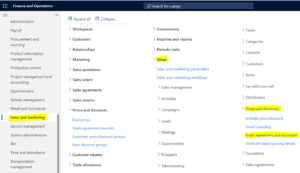
2. Click on ‘New’. Give a unique name and a generic description. In Relation tab, select the price related to the agreement.
Note: In example, Salesprice is selected in the name, Sales Price Agreement in description and Price (Sales) is selected in Relation tab.
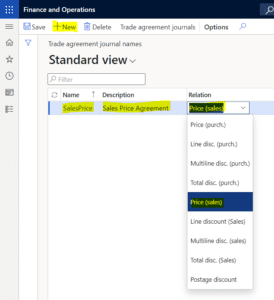
3. In Sales and Marketing module, click on Prices and Discounts and select Trade Agreement Journals.
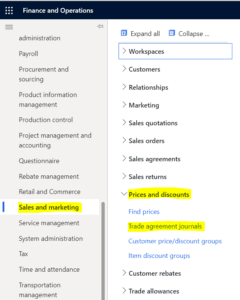
4. The ‘Party Code type’ and the ‘Product code type’ have the same values available to select : TABLE, GROUP, and ALL. For the ‘Party Code type’ field if one selects ‘Table’ the Account Selection field will allow us to select a specific customer account that this price will apply to . If you select ‘Group’ one will be able to select a customer price group, meaning that the price will apply to any customer that is associated with this price group. If ‘All’ is selected, the price is applicable to All customers. Similarly, with the ‘Product code type’ we can see the dropdown values in the ‘Item Relation’ field change from specific items, to item groups, to blank when ‘All’ is chosen.
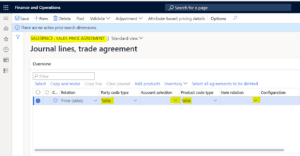
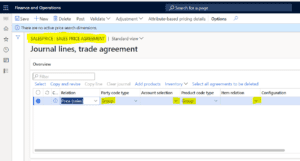
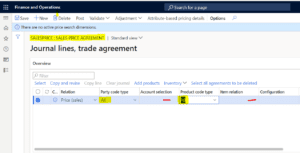
Note: The system finds the most specific price taking into account the combination of values selected in the ‘Party code type’ and ‘Product code type’ fields. For example, when an user is making two trade agreements that fall within the same validity dates. In the first agreement the ‘Party code type’ is set to ‘All’ which means it applies to all customers and ‘Product code type’ is set to ‘Table’ which means one has selected a specific item. On the second agreement, the ‘Party code type’ and ‘Product code type’ is set to ‘Table’ where the same products are selected. When one creates a Sales Order and create a line for that product the system will select the price on the second trade agreement because even though both trade agreement apply, the second trade agreement was the most specific one.
SALES TRADE AGREEMENT
- To create a Sales Trade Agreement, navigate to Sales and Marketing> Price and Discounts> Trade agreement journal.
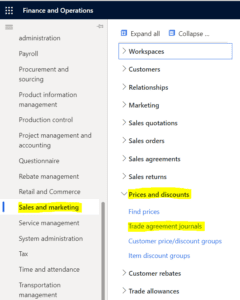
2. Click on ‘New’ from the Action pane and select the journal name from the list.
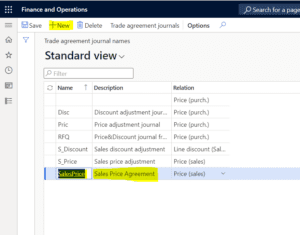
3. The page shows the Standard view with the Journal number and click on Lines from the action pane to enter more details.

4. Select the ‘Party code type’ as ‘Table’ and ‘Product code type’ as ‘Table’.
Note: In Account Selection tab 1001 is selected and in Item Relation D0003 is selected.
The blue information log saying “Active price search dimensions are : Site, Warehouse”. This means that the prices might differ by site or warehouse or by any product dimensions like size, color, style. If the pricing is dependent on these factors, one can enable pricing by these dimensions on storage dimension form (for site and warehouse) and on the product dimension group form (size, color, style and configuration).

5. Scrolling right, there are other fields like ‘From’ and ‘To’ which allows us to specify the quantity range that the price applies to. The unit of measure will be default based on the Inventory unit of measure. In the ‘Amount in currency’ field enter the unit price.


Note: In this example, we will create a price with a quantity break for a specific customer and part number. For a quantity of 1 to 1000 the price is 10 USD and if the quantity is 1001or more, the price is 9.50 USD. The quantity break is at 1000. ‘From’ 0 quantity, ‘To’ 1001 quantities are selected. The ‘From’ field is inclusive and the ‘To’ field is exclusive of quantities entered.
6. In the Details section, the price validity dates are to be entered in the From and To field. The ‘Price unit’ field is defined if the price that is entered is per 1 unit or per ‘x’ many units. The ‘Find next’ field indicates whether one wants the system to continue searching for a better price or if they want the system to stop searching once it finds this price. If one have two applicable prices for a vendor and we want the system to search for the best price for the vendor, one would leave this flag set to ‘Yes’. Generally, this is always set to ‘Yes’.
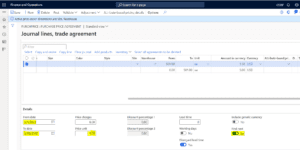
7. Finally, Click Post from the Action pane to complete the process.
SALES ORDER
- Navigate to Accounts Receivable module and select on All Sales Order and click on ‘New’ from the action pane.
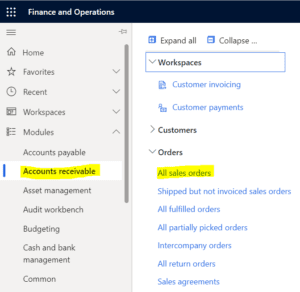
- Create a Sales Order for Customer US-001 with the item Number D0005 to validate the Sales Trade Agreement made.
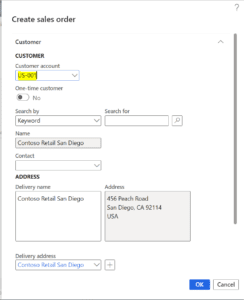
3. In line details, when the quantity is given as 100 (quantity between 0 – 1000), the price is shown as 10 USD and when the quantity is given as 2000 (quantity between 1001- unlimited), the price is shown as 9.50 USD as per the Sales Trade Agreement.
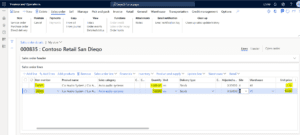
If you have any comments, please write to us at info@proso.ai.
